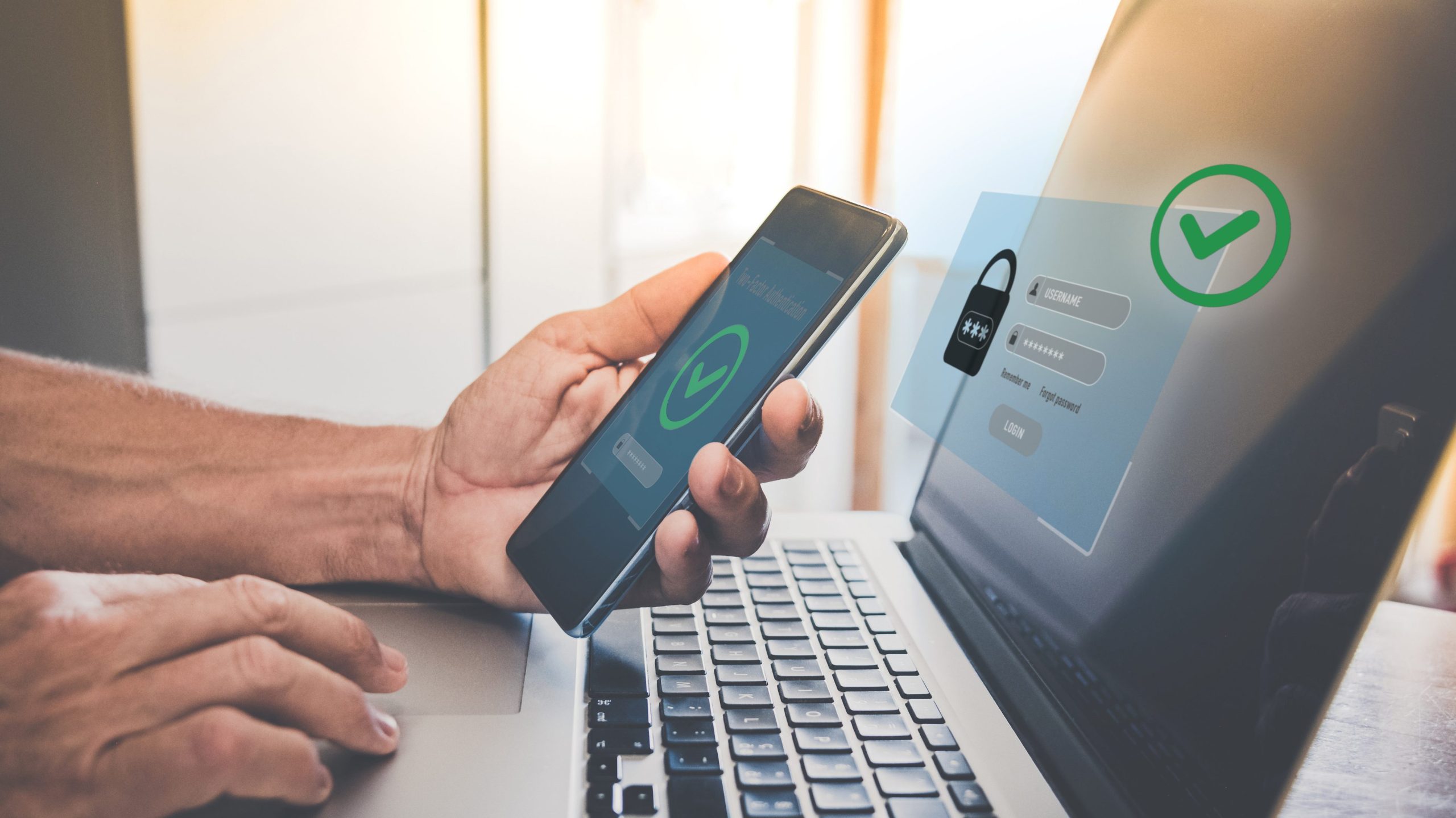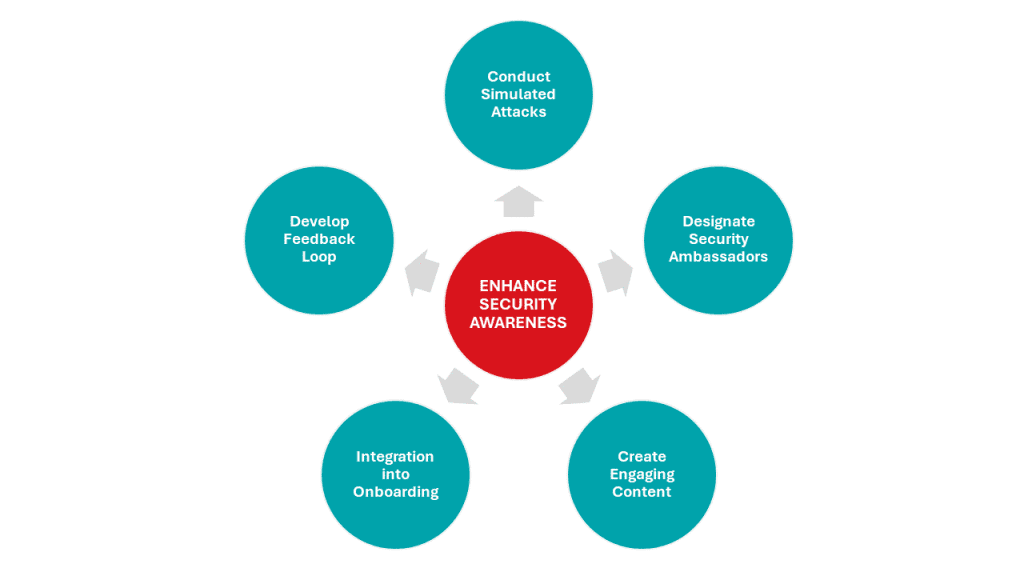Subscribe to Receive Updates
Join hundreds of business leaders and get our perspective on critical issues delivered to your inbox..

Your employees can play a pivotal role in safeguarding your organization’s digital assets and information. Let us take a deeper dive into the essential cybersecurity best practices for your employees, including maintaining strong passwords, being vigilant about phishing attempts, regularly updating software, securing physical devices, and fostering a culture of security awareness.
Strong Passwords: Emphasize creating strong, unique passwords to safeguard data and comply with security standards.
Phishing Vigilance: Train employees to recognize and respond to sophisticated phishing attempts to protect sensitive information.
Software Updates: Ensure regular updates to software to patch vulnerabilities and maintain compliance with security regulations.
Device Security: Secure physical devices with strong access controls, encryption, and safe storage practices.
Security Culture: Build a culture of security awareness through continuous training, clear communication, and leadership support.
One of the simplest yet most effective cybersecurity measures is the use of strong, unique passwords. Strong passwords are essential because they:
You should encourage your employees to create passwords that are difficult to guess, which include a mix of letters, numbers, and special characters. A strong password should have the following characteristics:

A recent study revealed that 88% of data breach incidents were caused by employee error. Therefore, being vigilant against phishing attempts is crucial as these types of cyberattacks are becoming increasingly sophisticated and prevalent.
Phishing is a method used by cybercriminals to deceive individuals into providing sensitive information, such as usernames, passwords, credit card details, or other personally identifiable information. This is often achieved using fraudulent emails, messages, websites, or phone calls that mimic legitimate organizations or individuals.
Understanding how to recognize and respond to phishing attempts is essential for protecting your organization from potential harm.
Phishing attempts can be recognized by several key indicators:
To protect against phishing attempts, you should adopt the following best practices for your employees:
If your employee suspects they have received a phishing attempt, they should report the attempt immediately.
Educating your employees on the importance of verifying the authenticity of emails and not clicking on links or downloading attachments from unknown sources is crucial in mitigating the risk of phishing attacks.
Keeping software up to date is another critical cybersecurity best practice for employees when protecting your organization against cyber threats. Cybercriminals often exploit vulnerabilities in outdated software to gain unauthorized access to systems and data.
Your employees should ensure that their operating systems, applications, and antivirus software are regularly updated to the latest versions. Automating software updates can help in ensuring that software is always up to date without relying on manual intervention.

In addition to digital security measures, physical security of devices is equally important. Advise your employees to never leave their devices unattended in public places and to use strong passwords or biometric security features to lock their devices.
Encrypting the data on devices adds an additional layer of security, making it difficult for unauthorized individuals to access information even if the device is lost or stolen.
Creating a culture of security awareness within your organization is the most important best practice. Regular training sessions should be conducted to educate employees about the latest cyber threats and the best practices for mitigating these risks.
Encouraging your employees to report suspicious activities and providing them with the tools and knowledge to do so can significantly enhance your organization’s cybersecurity posture.

Data breaches are a critical issue for businesses of all sizes and industries. Data breaches can occur through various means, including cyberattacks, phishing schemes, inadequate security controls, and human error.
When sensitive information such as customer data, financial records, or intellectual property is exposed, it can lead to loss of customer trust, legal penalties, and substantial financial costs associated with remediation efforts, regulatory fines, and potential litigation. Moreover, the aftermath of a breach often requires a substantial investment in enhancing security measures and rebuilding the organization’s reputation.
Organizations and individuals must stay informed about the latest security threats and emerging best practices for security. This includes staying updated on new forms of biometric authentication, advances in encryption technologies, and innovative physical security solutions.
Cybersecurity is a shared responsibility that requires the active participation of all your employees. By maintaining strong passwords, being vigilant against phishing attempts, regularly updating software, securing physical devices, and fostering a culture of security awareness, your employees can play a crucial role in protecting your organization from cyber threats.
Implementing cybersecurity awareness training is crucial, but understanding its effectiveness is equally important. Organizations can measure the impact through regular simulated phishing attacks to gauge employees’ susceptibility to such threats before and after training.
They can also track the number of reported incidents and measure changes in behavior through surveys and feedback mechanisms. Additionally, organizations can monitor the rate of password resets, MFA adoption, and adherence to software update policies as indicators of the training’s effectiveness.
Various industries are governed by specific regulatory standards that impact cybersecurity practices, such as the General Data Protection Regulation (GDPR) for businesses operating in or dealing with data from the European Union, the Health Insurance Portability and Accountability Act (HIPAA) for healthcare entities in the United States, and the Payment Card Industry Data Security Standard (PCI DSS) for businesses that handle credit card transactions.
These regulations often require robust data protection measures, including encryption, access controls, regular security assessments, and immediate breach reporting. Businesses must understand the specific requirements of these standards to ensure compliance and protect sensitive information effectively.
Remote work introduces several cybersecurity challenges, including securing home networks, protecting devices outside the corporate network, and managing the security of cloud-based applications. To address these challenges, organizations can enforce the use of virtual private networks (VPNs) for accessing company resources, implement endpoint security solutions, and provide guidelines for securing home networks.
Additionally, regular security training tailored to the remote work environment can help employees understand their role in maintaining security when working outside the office.
thirtyone3 technology provides you with the necessary security solutions to avoid breaches while protecting your data and systems from potential threats. This includes regular security updates, malware protection, data backups, endpoint monitoring, and other actions to help keep your business safe from cyberattacks.
Whether you need complete IT support or solutions that complement your existing resources, we are the IT partner that your business needs. Gain peace of mind knowing thirtyone3 technology has you covered.
If you have questions regarding your cybersecurity efforts or would like to schedule a security assessment, contact our tech experts at 623.850.5392 or by email at inquiries@thirtyone3technology.com.
Join hundreds of business leaders and get our perspective on critical issues delivered to your inbox..